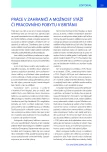PROGNOSIS OF PATIENTS WITH MODERATE AND HIGH-RISK NON-MUSCLE-INVASIVE BLADDER CANCER TREATED WITH INTRAVESICAL INSTILLATIONS OF MITOMYCIN C DURING UNAVAILABILITY OF BCG VACCINE
Authors:
Michael Pešl 1; Otakar Čapoun 1; Zuzana Vaľová 1; Roman Sobotka 1; Pavel Dundr 2; Tomáš Hanuš 1; Viktor Soukup 1
Authors‘ workplace:
Urologická klinika VFN a 1. LF UK, Univerzita Karlova, Praha
1; Ústav patologie VFN a 1. LF UK, Univerzita Karlova, Praha
2
Published in:
Ces Urol 2016; 20(4): 302-308
Category:
Original Articles
Overview
Purpose:
The aim of this study is to evaluate the prognosis in patients with moderate and highrisk non–muscle-invasive bladder cancer treated with intravesical instillations of mitomycin C (MMC) during a period of unavailability of the BCG vaccine.
Method:
We retrospectively evaluated a total of 66 patients with primary detection or recurrence of urothelial bladder cancer who had been diagnosed with Ta/T1 urothelial carcinoma between January 2012 and September 2014 and who had subsequently received intravesical treatment with mitomycin C. The median of follow-up was 25.5 months.
Results:
Thirty cases (45 %) had a moderate-risk and 36 cases (55 %) a high-risk tumour. In three patients, treatment was prematurely terminated due to adverse effects. In five cases, treatment with MMC was changed to intravesical immunotherapy owing to the resumption of supplies of the BCG vaccine.
We performed a comparison of the disease course in a subgroup of patients with pT1 G3 tumours treated with MMC (10 patients) with a control group (20 patients with a similar histological finding who underwent standard treatment with the BCG vaccine in the past; so-called “historical controls”).
During follow-up, recurrence occurred in 8 (27 %) patients with a moderate-risk and 13 (36 %) with a high-risk tumour; two (5.6 %) patients with a high-risk tumour were found to have progression to a muscle-invasive form of carcinoma. From a comparison with the historical controls, it was evident that patients with a pT1 G3 tumour had significantly higher recurrence rates if they were treated with adjuvant intravesical chemotherapy using mitomycin C (p = 0.0394).
Conclusion:
When treating patients with high-risk bladder cancer by means of intravesical chemotherapy, it is necessary to expect a higher recurrence risk than in those with moderate-risk tumours. The risk of progression was not evaluated. In the case of T1 G3 carcinoma, the treatment with MMC is associated with a significantly higher risk of recurrence than in patients undergoing standard treatment with the BCG vaccine.
Key words:
BCG vaccine, instillation therapy, intravesical chemotherapy, mitomycin C, bladder tumours.
Sources
1. Ferlay JSH, Bray F, Forman D, et al. GLOBOCAN 2012, Cancer Incidence and Mortality Worldwide: IARC CancerBase 2012, International Agency for Research on Cancer: Lyon, France.
2. Sylvester RJ, van der Meijden APM, Oosterlinck W, et al. Predicting recurrence and progression in individual patients with stage TaT1 bladder cancer using EORTC risk tables: a combined analysis of 2596 patients from seven EORTC trials. Eur Urol 2006; 49: 466–477.
3. Babjuk M, Böhle A, Burger M, et al. EAU Guidelines, 2016.
4. Böhle A, Jochman D, Bock PR, et al. Intravesical bacillus Calmette-Guerin versus mitomycin C for superficial bladder cancer: a formal meta-analysis of comparative studies on recurrence and toxicity. J Urol, 2003; 169: 90.
5. Malmström PU, Sylvester RJ, Crawford RJ, et al. An individual patient data meta-analysis of the long‑term outcome of randomised studies comparing intravesical mitomycin C versus bacillus Calmette-Guerin for non-muscle-invasive bladder cancer. Eur Urol, 2009; 56: 247.
6. Sylvester RJ, Brausi MA, Kirkels WJ, et al. Long-term efficacy results of EORTC genito-urinary group randomized phase 3 study 30911 comparing intravesical instillations of epirubicin, bacillus Calmette-Guerin, and bacillus Calmette-Guerin plus isoniazid in patients with intermediate- and high-risk stage Ta T1 urothelial carcinoma of the bladder. Eur Urol, 2010; 57: 766.
7. Järvinen R, Kaasinen E, Sankilo A, Rintala E, Finn Blader Group. Long-term efficacy of maintenance
bacillus Calmette-Guerin versus maintenance mitomycin C instillation therapy in frequently recurrent
TaT1 tumours without carcinoma in situ: a subgroup analysis of the prospective, randomised FinnBladder
I study with a 20-year follow-up. Eur Urol, 2009; 56: 260.
8. Pawinski A, Sylvester R, Kurth KH, et al. A combined analysis of EORTC and Medical Research Council
randomised clinical trials for the prophylactic treatment of stage TaT1 bladder cancer. J Urol 1996; 156:
1934–1940.
9. Sylvester RJ, van der Meijden AP, Lamm DL, et al. Intravesical bacillus Calmette-Guerin reduces the
risk of progression in patients with superficial bladder cancer: a meta-analysis of the published results of
randomised clinical trials. J Urol 2002; 168: 1964–1970.
10. Böhle A, Bock PR. Intravesical bacille Calmette-Guerin versus mitomycin C in superficial bladder cancer:
formal meta-analysis of comparative studies on tumor progression. Urology, 2004; 63: 682.
Labels
Paediatric urologist Nephrology UrologyArticle was published in
Czech Urology

2016 Issue 4
Most read in this issue
- PROGNOSTIC SIGNIFICANCE OF PARAMETERS ARISING FROM THE RATIO OF NEUTROPHILS AND LYMPHOCYTES IN INVASVIE BLADDER NEOPLASMS
- BLADDER SPARING TREATMENT FOR MUSCLE-INVASIVE BLADDER CANCERS
- URINARY SYMPTOMS IN PATIENTS WITH MULTIPLE SCLEROSIS. AS UROLOGISTS, ARE WE IMPORTANT IN THE ALGORITHM OF SPECIALIZED CARE OF PATIENT WITH MULTIPLE SCLEROSIS?
- HIBERNOMA AS A SURPRISING FINDING DURING PERIRENAL TUMOUR EXSTIRPATION
